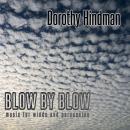Triangle of Resistance
Triangle of Resistance
New York, NY
| Miya Masaoka: Triangle of ResistanceiTunes Album Page | |||
|---|---|---|---|
| Song Title | Time | Price | |
| 1. | Triangle of Resistance: I. The Long Road | 12:23 | |
| 2. | Triangle of Resistance: II. The Clattering of Life | 19:57 | |
| 3. | Triangle of Resistance: III. Survival | 10:19 | |
| 4. | 4 Moons of Pluto (Live) | 16:21 | |
Triangle of Resistance takes its title from the three-part suite by composer Miya Masaoka that opens the album. Masaoka’s family was one of those imprisoned by the government during World War II under Executive Order 9066, and she relates a story about her mother in the liner notes: “She said the U.S. government tacked paper posters of Executive Order 9066 on street lamps informing Japanese Americans living in California that they were about to be interned. She was in Junior High School, and excelled in French and violin, and she was standing there reading the wheat-pasted poster. A passer-by shouted at her, ‘Read it good, Jap!’ She was about to be taken from her home, pulled from school, and go to a prison camp for four years.”
Masaoka wanted the music to convey the complex emotions her mother experienced during her internment. Played by a “double ensemble” consisting of a string quartet, percussion, synthesizer, and koto, conducted by Richard Carrick, “Triangle of Resistance” conveys the horror, chaos, and stoicism of that experience.
“Four Moons of Pluto”, by way of contrast, explores another kind of space. Masaoka and her neighbor, bassist James Ilgenfritz, identified a lexicon of areas on the double bass that had extraordinary kinds of resonance. She then composed an idiosyncratic structure that shifts in and around these resonant spots. Like the orbits of planets, musical intervals are expressed in small number ratios, and here the detuned bass plumbs sonic depths that mirror the music of the spheres.
Together these works show Masaoka’s intimate and dramatic connection to the world of sonority and textures of human history.
Miya Masaoka resides in New York City and is a classically trained musician, composer and sound/installation artist. She has created works for solo koto, laser interfaces, laptop and video, sculpture installations and written scores for ensembles, chamber orchestra and mixed choirs. She has a large body of work for solo koto, live electronics and video. She often works with the sonification of data, and maps the behavior of brain activity, plants and insect movement to sound. Her work has been performed at the Venice Biennale 2004, the Miller Theater, NYC, Ircam, Paris and V2, Rotterdam. Awards and commissions include the Alpert Arts Award, Bang On a Can, Engine 27/Harvestworks, and Gerbode Foundation. She is currently in Japan researching Noh drama. Masaoka has been named interim director of the Sound Arts MFA at Columbia University.
CADENCE
"I love the mix of a traditional Japanese instrument with western instruments in a largely western compositional style. The interplay between the instruments is interesting. I love the contrast between the strings and the koto, which, of course, is a stringed instrument. The strings and koto are the primary instruments but receive excellent support from the synth and percussion."
—Bernie Koenig
"Triangle of Resistance is also notable since the composer’s own contributions are sparse, leaving most of the heavy lifting to the other players. Additionally despite the use of some Oriental instruments the intention of the suite is innovation, not exotica. Based on extensions created by detuned double bass strings, Masaoka’s “Four Moons of Pluto” interpreted by James Ilgenfritz rounds out the disc. With a contortionist’s ability to expand beyond conventional positions, at points lgenfritz appears to be playing several basses at once or even sounding a reed instrument, meeting the challenge with bass work as remarkable at high-pitch tessitura as at galloping drones. The composition confirms Masaoka’s range, but is a tributary to the oceanic “Triangle of Resistance”." [FULL ARTICLE] - Ken Waxman
“Well-known experimenter in various musical genres, an expert interpreter of the koto, Miya Masaoka presents on this CD two works quite different for organic and color, but stylistically homogeneous, both of which Both of which can be placed between the same contemporary realm...The mixture of sounds, almost always suspended and discontinuous, evokes in fact been changing the oppressive mood, anxiety, uncertain expectations. Overall, it is a stimulating record, to listen carefully, not so much because of its structural complexity, But to capture the contents Masaoka wanted to evoke.” [FULL ARTICLE] - Neri Pollastri



